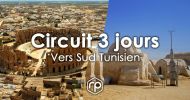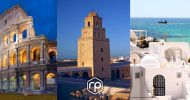Tunisia has been a crossroads of civilizations for millennia. Although it is the smallest nation in North Africa, it is brimming with history, culture, and natural beauty that rivals much larger countries. Behind its famous beaches lies a land rich with vibrant medinas, picturesque Berber villages, ancient archaeological sites, and a legendary hospitality.
Our journey begins in Tunis, the vibrant capital. Its historic heart, the Medina of Tunis, a UNESCO World Heritage site, offers an immersion into over a thousand years of tradition. Colorful souks, traditional houses, and the majestic Zitouna Mosque reflect the city’s rich cultural heritage.
Just a few kilometers away, the ruins of Carthage recall the ancient power of this mythical city. And on the hilltops, the blue-and-white village of Sidi Bou Saïd enchants with its artistic charm and breathtaking views of the Mediterranean.
Further south, the Berber village of Takrouna overlooks olive groves, offering a unique glimpse into Amazigh culture. In Sousse, the beaches meet a vibrant medina, dominated by the Ribat and the archaeological museum, one of the richest in the country.
The coastline continues to amaze all the way to Monastir, where the Ribat and the Mausoleum of Habib Bourguiba mark Tunisia’s modern history. Then comes El Jem and its Roman amphitheater, the third largest in the world, a true ancient gem in the heart of a small town.
Inland, Kairouan, a holy city of Islam, impresses with its Great Mosque and world-renowned carpet craftsmanship. Every alley in its medina echoes with history and ongoing spiritual devotion.
Heading south into the Tunisian Sahara, in Tozeur you’ll find clay-brick houses, a lush palm-tree oasis, and villages like Chebika, Mides, or Tamerza that transport visitors to another world. Further on, near Douz and Sabria, you can sleep in a Saharan camp, among the dunes under a sky of rare purity filled with stars.
Every step in Tunisia is a surprise. It’s a country where you can go from sea to desert, from mountains to medinas, all while meeting a warm and proud population deeply rooted in their heritage.
Why visit Tunisia?
- A variety of landscapes: beaches, mountains, oases, and desert
- A unique historical heritage: Carthage, El Jem, Kairouan
- A rich culture blending Arab, African, and European traditions
- Delicious cuisine: couscous, makroudh, briks, dates
- A warm welcome and authentic hospitality
Frequently Asked Questions
What is the best time to visit Tunisia?
Spring (April–May) and autumn (September–October) are ideal for enjoying the mild weather and avoiding the summer crowds.
What are the must-see sites?
Tunis and its medina, Carthage, Sidi Bou Saïd, El Jem, Kairouan, the Sahara Desert, and Berber villages like Tamezret or Takrouna.
Is it safe to travel in Tunisia?
Yes, Tunisia is a safe tourist destination in most regions, with a warm welcome and constantly improving infrastructure.
Exploring Tunisia means traveling through time, marveling at its diversity, and discovering a land of a thousand faces. Whether you are a culture lover, a nature enthusiast, or simply seeking relaxation, Tunisia will surprise and enchant you.
Ready to live this unforgettable adventure?
Book your trip and activities in Tunisia now at www.resaprivee.com for a tailor-made and authentic experience.













